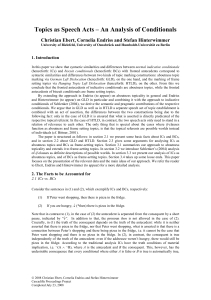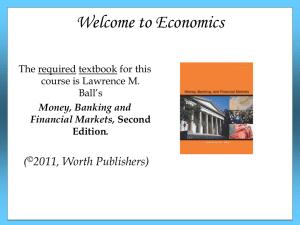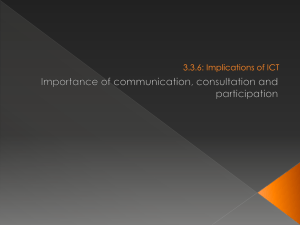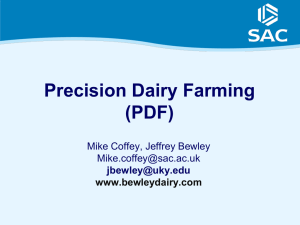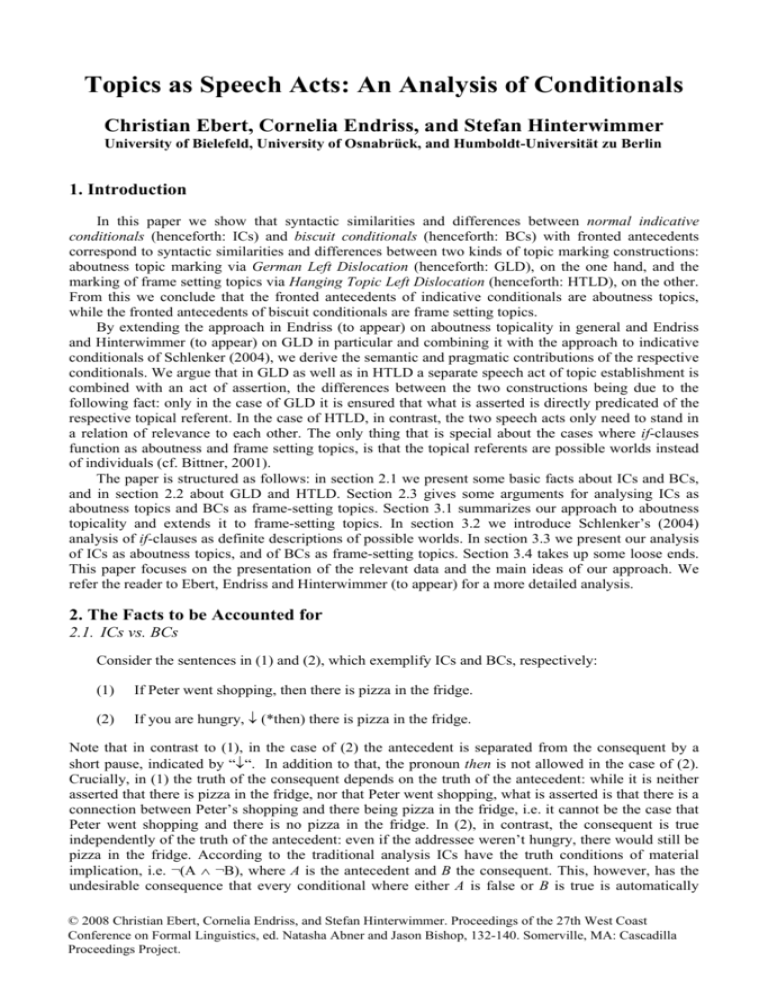
Topics as Speech Acts: An Analysis of Conditionals
Christian Ebert, Cornelia Endriss, and Stefan Hinterwimmer
University of Bielefeld, University of Osnabrück, and Humboldt-Universität zu Berlin
1. Introduction
In this paper we show that syntactic similarities and differences between normal indicative
conditionals (henceforth: ICs) and biscuit conditionals (henceforth: BCs) with fronted antecedents
correspond to syntactic similarities and differences between two kinds of topic marking constructions:
aboutness topic marking via German Left Dislocation (henceforth: GLD), on the one hand, and the
marking of frame setting topics via Hanging Topic Left Dislocation (henceforth: HTLD), on the other.
From this we conclude that the fronted antecedents of indicative conditionals are aboutness topics,
while the fronted antecedents of biscuit conditionals are frame setting topics.
By extending the approach in Endriss (to appear) on aboutness topicality in general and Endriss
and Hinterwimmer (to appear) on GLD in particular and combining it with the approach to indicative
conditionals of Schlenker (2004), we derive the semantic and pragmatic contributions of the respective
conditionals. We argue that in GLD as well as in HTLD a separate speech act of topic establishment is
combined with an act of assertion, the differences between the two constructions being due to the
following fact: only in the case of GLD it is ensured that what is asserted is directly predicated of the
respective topical referent. In the case of HTLD, in contrast, the two speech acts only need to stand in
a relation of relevance to each other. The only thing that is special about the cases where if-clauses
function as aboutness and frame setting topics, is that the topical referents are possible worlds instead
of individuals (cf. Bittner, 2001).
The paper is structured as follows: in section 2.1 we present some basic facts about ICs and BCs,
and in section 2.2 about GLD and HTLD. Section 2.3 gives some arguments for analysing ICs as
aboutness topics and BCs as frame-setting topics. Section 3.1 summarizes our approach to aboutness
topicality and extends it to frame-setting topics. In section 3.2 we introduce Schlenker’s (2004)
analysis of if-clauses as definite descriptions of possible worlds. In section 3.3 we present our analysis
of ICs as aboutness topics, and of BCs as frame-setting topics. Section 3.4 takes up some loose ends.
This paper focuses on the presentation of the relevant data and the main ideas of our approach. We
refer the reader to Ebert, Endriss and Hinterwimmer (to appear) for a more detailed analysis.
2. The Facts to be Accounted for
2.1. ICs vs. BCs
Consider the sentences in (1) and (2), which exemplify ICs and BCs, respectively:
(1)
If Peter went shopping, then there is pizza in the fridge.
(2)
If you are hungry, ↓ (*then) there is pizza in the fridge.
Note that in contrast to (1), in the case of (2) the antecedent is separated from the consequent by a
short pause, indicated by “↓“. In addition to that, the pronoun then is not allowed in the case of (2).
Crucially, in (1) the truth of the consequent depends on the truth of the antecedent: while it is neither
asserted that there is pizza in the fridge, nor that Peter went shopping, what is asserted is that there is a
connection between Peter’s shopping and there being pizza in the fridge, i.e. it cannot be the case that
Peter went shopping and there is no pizza in the fridge. In (2), in contrast, the consequent is true
independently of the truth of the antecedent: even if the addressee weren’t hungry, there would still be
pizza in the fridge. According to the traditional analysis ICs have the truth conditions of material
implication, i.e. ¬(A ∧ ¬B), where A is the antecedent and B the consequent. This, however, has the
undesirable consequence that every conditional where either A is false or B is true is automatically
© 2008 Christian Ebert, Cornelia Endriss, and Stefan Hinterwimmer. Proceedings of the 27th West Coast
Conference on Formal Linguistics, ed. Natasha Abner and Jason Bishop, 132-140. Somerville, MA: Cascadilla
Proceedings Project.
133
true, which does not correspond to speakers’ intuitions. Therefore, the most popular view nowadays (at
least among linguists1) is the following one: a conditional with antecedent A and consequent B is true
if in every world where A is true and which is furthermore as close to the actual world as possible, B is
true as well (Warmbrod 1983, Kratzer 1986, Nolan 2003; cf. Lewis 1973).
This account obviously does not work for BCs, since it is not asserted that the consequent is only
true in those worlds where the antecedent is true. Therefore, BCs have been analysed as conditional
assertions by de Rose and Grandy (1999): while the truth of the consequent does not depend on the
truth of the antecedent, the speaker’s assertion of the consequent is dependent on the truth of the
antecedent, i.e. the speaker only asserts the consequent under the condition that the antecedent is true.
This analysis has been criticised by Siegel (2006) because it cannot account for examples like (3)
below, where the speaker presumably is not even present at the situations that would make the
antecedent true, and therefore cannot be assumed to assert the consequent then.
(3)
If they ask you how old you are, ↓ you’re under 14.
Siegel (2006) therefore analyses BCs as involving existential quantification over potential relevant
literal speech acts., i.e. in a case like (3) the speaker asserts that in all worlds where the antecedent is
true there is a potential relevant literal act of asserting the consequent. The problem with these
accounts is that they are both too weak. To see this, consider the examples in (4) and (5):
(4)
If you don‘t want to watch the movie, ↓ the gardener is the killer.
(5)
If the congregation is ready, ↓ I hereby declare you man and wife.
Note that no matter whether the addressee wants to watch the movie or not, the speaker spoiled it by
uttering (4). Likewise, in the case of (5) the declaration of marriage happened independently of the
readiness of the congregation. An often observed characteristic feature of BCs that seems right to us,
however, is the following: the antecedent gives conditions stating when the consequent is relevant
(hence the term relevance conditional). In the case of (2), for example, it is understood that the speaker
assumes the assertion that pizza is in the fridge to be relevant to the listener only in case s/he is hungry.
A unified theory of ICs and BCs should thus account for the (in)dependence of the truth of antecedent
and consequent in the two cases as well as for the observed relevance effects. As we will see in section
2.3 and section 3, such an analysis is possible if the assumption of a close connection between
conditional antecedents and topicality (see e. g. Haiman 1978 and Bittner 2001) is sharpened in the
following way: the antecedents in ICs and BCs are analysed as instantiating two kinds of topics that
bear different relations to their respective comments. We will show that the antecedents of ICs are
aboutness topics that accordingly bear a direct predication relation to their comments, while the
antecedents of BCs are frame-setting topics that stand in an unspecified relevance relation to their
comments.
In the next section we will therefore have a closer look at two kinds of topic marking
constructions in German: GLD and HTLD. The first has been argued to indicate aboutness topicality at
the sentence level, and the second to shift the discourse topic.
2.2. Two Kinds of Topic Marking Construction: GLD vs. HTLD
Consider the examples in (6) and (7), which exemplify GLD and HTLD, respectively2:
1
Among philosophers of language the possible world analysis is often reserved for counterfactuals, for which it
was originally developed by Lewis (1973). Indicative conditionals, in contrast, are treated as being completely
different objects. They do not have truth conditions at all and their impact can roughly be described as follows
(following Ramsey, 1994; orig. 1929): the speaker tells the hearer that she, upon hypothetically adding the
antecedent proposition to the stock of propositions believed by her, accords the consequent proposition a high
chance of being true as well, and asks the hearer to do the same thing (see Bennett 2003 for discussion and
references).
2
In the gloss, RP stands for resumptive pronoun.
134
(6)
(7)
Den
Pfarrer, den
kann
keiner leiden.
The-ACC pastor RP-ACC can
nobody like.
‘The pastor nobody likes.’
Der
Pfarrer, ↓ keiner
kann
ihn
leiden.
The-NOM pastor
nobody can
him
like.
‘The pastor, nobody likes him.’
Note that the English counterparts illustrated by the glosses are often called topicalization and left
dislocation, respectively (Prince 1998). For reasons of space, we will concentrate on the German
variants in the following, whose defining characteristics can be summarized as follows, following Frey
(2004) (who builds on Altmann 1981):
(A)
In the case of HTLD, the left peripheral phrase is separated from the rest of the sentence by
a short pause. In the case of GLD, there is no pause.
(B)
In the case of HTLD, the resumptive element may show up in the form of a personal
pronoun (as shown in (7) above), a weak d-pronoun like der, a strong pronoun like dieser,
an epithet or a definite description. In the case of GLD, only a weak d-pronoun is allowed
(as shown in (6) above).
(C)
In the case of HTLD, the resumptive element may show up either in the prefield or in the
middlefield of the clause (as shown in (7) above)). In the case of GLD, the resumptive
element is preferably realized in the prefield, i.e. in Spec., CP of the matrix clause, as
shown in (6) above.
(D)
In the case of HTLD, the left peripheral element may either be in the nominative (as shown
in (7) above) or in the same case as the resumptive element, if it is a DP. In the case of
GLD, it has to in the same case as the resumptive element.
(E)
In the case of HTLD, a pronoun contained within the left peripheral constituent may not be
bound by a quantifier contained within the matrix clause, as shown in (8a) below (from
Frey (2004: 3)). In the case of GLD, in contrast, pronoun binding from within the matrix
clause is unproblematic, as shown in (8b):
(8)
a. *Sein1
Doktorvater/*Seinen1 Doktorvater, ↓ [jeder Linguist]1
his-NOM advisor
his-ACC advisor
every linguist
b. Seinen1
Doktorvater, den
verehrt [jeder Linguist]1.
his-ACC advisor
RP-ACC admires every linguist.
‘Every linguist admires his supervisor.’
verehrt ihn.
admires him.
Note that the binding facts give us a clear criterion to distinguish instances of GLD from instances of
HTLD. We will come back to this point in section 2.3, where we argue that ICs whose antecedent is
resumed by dann (then) instantiate GLD, while BCs with fronted if-clauses instantiate HTLD.
Frey (2004) shows that only in the case of GLD the left peripheral constituent unambiguously
function as the aboutness topic of the respective sentence, i.e. as the entity the sentence is about, while
the function of HTLD is to indicate a shift of the discourse topic. This is shown by the contrast
between (9a) and (9b) (from Frey 2004: 20):
(9)
Ich
I
habe
have
etwas
something
in
in
der Zeitung
the newspaper
a. Den
Hans,
the-ACC H.
den
will
RP-ACC wants
der Minister
the minister
b. #Hans, ↓ der
H.
the
Minister will
minister wants
ihn zum
him to
über
about
zum
to
Hans
H.
gelesen.
read.
Botschafter ernennen.
ambassador (to) appoint.
Botschafter ernennen.
ambassador (to) appoint.
135
In (9), the first sentence establishes Hans as the current discourse topic. (9a), which exemplifies GLD,
is fine, since Hans is accordingly marked as the aboutness topic of the following sentence, which gives
us the crucial information about Hans. (9b), in contrast, which exemplifies HTLD, is out. This shows
that HTLD can only be used in order to establish a new discourse topic.
Frame-setting topic constructions are well attested in the languages of the world (see Maslova and
Bernini 2006 for an overview). Interestingly, in many languages entities can function as frame-setting
topics that are not taken up by proforms within the matrix clause to which the constituent marked as
the frame-setting topic has been juxtaposed. This is illustrated with two examples from Japanese and
Korean below:
(10)
Japanese (from Chen 1996: 402)
Nihon
wa syoto ga
sumi-yo-i
TOP capital NOM
live-good-PRS
Japan
‘As for Japan, its capital is a good place to live.’
(11)
Korean (from Li and Thompson 1976: 468)
Pihengi-nin
747-ka khi-ta
Airplane-TOP 747-SBJ big-STAT
‘As for airplanes, the 747 is big.’
As indicated by the glosses, in English a conventionalised expression like as for..., as concerns/
regards... has to be used in such cases, at least in more formal registers. The same is true of German
and most other European languages. (12) is an English example similar to the examples in (10) and
(11) insofar as (i) the left peripheral constituent is not taken up by a proform within the matrix clause
and (ii) the semantic relation holding between the entity denoted by the topical constituent and the
proposition denoted by the matrix clause is not linguistically encoded and is thus left completely
unspecified:
(12)
As for the pastor, ↓ the marriage sermon was wonderful.
Note, however, that in all the examples in (10) – (12) the proposition denoted by the matrix clause is
implied to be relevant w.r.t. (questions regarding) the entity denoted by the topical constituent, i.e. the
matrix clause can be construed as answering a question concerning Japan (where in Japan can you live
well?), airplanes in general (which airplanes are big?) or some contextually salient pastor (how did the
pastor perform on the marriage?).
In the following section we give some arguments for analysing the antecedents of ICs as
aboutness topics marked via left dislocation, and the antecedents of BCs as frame-setting topics.
2.3. ICs and BCs as Instantiating Two Kinds of Topic Marking Constructions
It has often been observed that there is a strong syntactic similarity between ICs (and subjunctive
conditionals) and correlative constructions, which „involve a free relative clause adjoined to the matrix
clause and coindexed with a proform inside it“ (Bhatt and Pancheva 2001). Then can therefore be
regarded as a proform which relates back to the possibilities introduced by the if-clause (see e.g. also
Iatridou 1994), i.e. its function is the same as that of the resumptive pronouns present in the prefield of
the GLD-examples discussed in section 2.1. Recall that in the case of BCs, in contrast, then is
prohibited, i.e. if the proform then is present, the sentence is automatically interpreted as an IC. In
addition to the presence/absence of a weak d-pronoun in the clause-initial position of the matrix
sentence, there are other telling parallels between GLD and ICs, on the one hand, and HTLD and BCs,
on the other.
(A)
As with HTLD, the left peripheral if-clause is separated from the rest of the sentence by a
short pause in the case of BCs. In the case of ICs with left peripheral if-causes, in
contrast, there is no such pause, just as with GLD.
136
(B)
As with HTLD, binding into the left peripheral if-clause is impossible in the case of BCs,
as shown by (13a) below. In the case of ICs, in contrast, binding from within the matrix
clause is possible, just as with GLD, as shown by (13b) (see also Haegeman, 2003):
(13)
[jede Orchidee]i mehrmals
im Jahr.
a. Wenn man siei gut pflegt, dann blüht
if
one it well groom then blossoms every orchid
several times in the year.
‘Every orchid blossoms several times a year, if you groom it well.’
b. *Wenn Du etwas
über siei wissen willst, [jede Orchidee]i blüht
if
you something about it to know want, every orchid
blossoms
mehrmals
im
Jahr.
several times in the year
(C)
As HTLD can only be used to shift the discourse topic, the propositional content of the
if-clause has to be novel in order for a BC to be fully acceptable, as shown by the oddity
of the mini discourse in (14a). In the case of ICs, in contrast, there is no problem if the
propositional content of the if-clause is already discourse given, as shown by (14b).
Again, this is parallel to GLD.
(14)
a. A: I’m thirsty. B: #If you’re thirsty, ↓ there’s beer in the refrigerator.
b. A: I’m thirsty. B: If you’re thirsty, then let’s have a break and get something to drink.
We take these parallels as evidence that ICs with left-dislocated antecedents resumed by then are
instances of GLD where the if-clause functions as the aboutness topic, while in the case of BCs the left
peripheral if-clause functions as the frame-setting topic. In section 3 we will see that the semantic and
pragmatic contributions of ICs and BCs are captured by (a) extending the approach to aboutness topics
in general by Endriss (to appear) (cf. also Ebert and Endriss, 2004) and to GLD in particular by
Endriss and Hinterwimmer (to appear) to frame setting topics and (b) combining it with the approach
to indicative conditionals by Schlenker (2004), who treats if-clauses as definite descriptions of possible
worlds.
3. ICs as Aboutness Topics and BCs as Frame-setting Topics
3.1. Our Approach to Topicality in General
Endriss (to appear) argues that aboutness topics must be interpreted in a separate speech act of topic
establishment REFX, resembling an act of referring (Searle 1969) or frame setting (Jacobs 1984). This
act formally establishes a new aboutness topic by introducing a new discourse referent X for the topicmarked constituent. The remainder of the sentence (i.e. the comment) is then interpreted as a predicate
that applies to this discourse referent X inside the originating speech act. Crucially, the REFX act is
performed before this originating act. In the following we will restrict ourselves to assertions for the
sake of a simple exposition. In this case, an assertion of a proposition structured into topic and
comment is interpreted as indicated in the schema in (15).
(15)
REFX (TOPIC) & ASSERT(COMMENT(X))
The REFX act establishes the topic by introduction of a new discourse referent X followed by a
subsequent speech act of asserting that the comment holds of X. The two speech acts are conjoined via
speech act conjunction &. We have to leave things at this schematic level here and refer the reader to
Endriss (to appear) and Endriss, Ebert and Hinterwimmer (to appear) for more detail on the analysis.
Concerning the case where aboutness topics are explicitly marked via GLD, Endriss and
Hinterwimmer (to appear) assume that the d-pronoun in the specifier of the matrix-CP is interpreted
like a relative pronoun, i.e. that it triggers lambda-abstraction. In a sentence such as (6), repeated
below as (16a), the matrix clause is thus interpreted as (16b), while the entire sentence is interpreted as
shown schematically in (16c):
137
(16)
a. Den
Pfarrer, den
kann keiner leiden.
The-ACC pastor RP-ACC can
nobody like.
‘The pastor nobody likes.’
b. λy. ¬∃z[like(z, y)]
c. REFX (ιx[pastor(x)]) & ASSERT(¬∃z[like(z, X)])
Note that we do not observe any truth conditional effect comparing (16c) to the (non-topical) standard
analysis that would derive an assertion of ¬∃z[like(z, ιx[pastor(x)])]. This is different if the topicmarked constituent is an indefinite. In this case, a widest (possibly island-free) scope reading for the
indefinite is derived (see Endriss, to appear, for details). Concerning an HTLD-example like the one in
(7), repeated here as (17a), we assume that it is interpreted as shown in (17b):
(17)
a. Der
Pfarrer, ↓ keiner
kann
ihn
The-NOM pastor
nobody can
him
‘The pastor, nobody likes him.’
b. REFX (ιx[pastor(x)]) & ASSERT(¬∃z[like(z, y)])
leiden.
like.
In the case of HTLD, the act of topic establishment has exactly the same effect. But since the matrix
clause is not interpreted as a lambda-abstract, its denotation cannot be applied to the topical discourse
referent. Instead, the matrix clause is interpreted as an independent assertion that is simply conjoined
with the act of topic establishment via speech act conjunction. The proform in (17a) is thus treated as a
free variable that needs to be resolved. Since the topic is the most salient discourse referent in (19a),
the free variable y has to be resolved to it.
Hence in the case of frame-setting topics, the relation between topic and is not simply one of
predication, as becomes even clearer by considering the interpretation of (12) (repeated here as (18a))
shown in (18b):
(18)
a. As for the pastor, ↓ the marriage sermon was wonderful.
b. REFX (ιx[pastor(x)]) & ASSERT(wonderful(marriage_sermon))
Since (18a) does not contain any proform whatsoever, the only connection of topic and comment is via
their consecutive performance as speech acts. Here the issue of relevance comes into play: using
standard Gricean assumptions, an assertion is only felicitous if it is relevant to the preceding discourse.
In (18a), the pastor is established as the topic. The following assertion thus has to be relevant with
respect to the pastor, i.e. it has to be construable as answering (at least indirectly) a question that
increases the addressee‘s knowledge about the pastor. This is exactly the pragmatic effect we observe
in the case of frame setting constructions. Note that in the case of aboutness topics, the relevance
condition is trivially fulfilled, because a predication is obviously relevant to its argument. With these
assumptions in place, let us now turn to ICs and BCs.
3.2. If-Clauses as Definite Descriptions of Possible Worlds
We follow Schlenker (2004), who builds on Stalnaker (1968), in analysing the antecedents of
conditionals as definite descriptions of possible worlds: they denote the unique possible world which is
most similar to the actual world w0 among all possible worlds where the respective proposition is true.
The if-clause in (1), repeated below as (19a), thus denotes the object in (19b): the unique world w
which is most similar to the actual world w0 among all possible worlds where Peter went shopping3.
(19)
3
a. If Peter went shopping, then there is pizza in the fridge.
b. ιw0w[went_shopping(w)(peter)]
The subscript at the iota-operator ι indicates the world of evaluation w.r.t. which ‘similarity’ is measured. We
ignore the issue of plurality necessary for cases of quantification over possible worlds here (cf. Schlenker, 2004).
138
The proposition denoted by the consequent is then applied to the denotation of the if-clause, which
gives us (20):
(20)
pizza_is_in_the_fridge(ιwow[went_shopping(w)(peter)])
‘The unique world where Peter went shopping which is most similar to the actual world
is among all the worlds where pizza is in the fridge.’
3.3. ICs as Aboutness Topics, BCs as Frame-setting Topics
Based on our observations concerning the parallels between ICs and GLD we assume that the if-clause
in (19a) is actually interpreted as the aboutness topic: the act of topic establishment introduces a
discourse referent X for the unique world denoted by the if-clause, and it is then asserted that the
predicate of worlds denoted by the consequent holds of X.
Note that we assume the proform then in Spec., CP to trigger lambda-abstraction over possible
worlds in exactly the same way in which d-pronouns like der trigger lambda-abstraction over
individuals. It is thus guaranteed that the predicate denoted by the consequent applies to the discourse
referent established as the topic by the first speech act, and we get (21) as the interpretation of (19a):
(21)
REFX (ιw0w[went_shopping(w)(peter)]) & ASSERT(pizza_is_in_the_fridge(X))
Again, (21) is truth conditionally equivalent to (20), similar to the individual case in (16). Since we
deal with a simple case of predication, the relevance requirement again is trivially fulfilled. Let us now
turn to BCs, which, crucially, do not allow the proform then in the consequent. The consequent is thus
not interpreted as a predicate that applies to the topical discourse referent, but as an independent
assertion, i.e. the predicate of worlds is applied to the actual world by default. Our example (2),
repeated here as (22a), is therefore interpreted as shown in (22b):
(22)
a. If you are hungry, ↓ (*then) there is pizza in the fridge.
b. REFX (ιw0w[hungry(w)(listener)]) & ASSERT(pizza_is_in_the_fridge(w0))
That there is pizza in the fridge is thus asserted unconditionally, which is exactly what we observed for
BCs. Note that our analysis of BCs as involving frame-setting topics automatically accounts for the
fact that then is not allowed in BCs: the consequent would then necessarily be interpreted as a
predicate that applies to the world denoted by the if-clause. Consequently, it would no longer be
asserted unconditionally, and the respective sentence would be interpreted as an ordinary IC (which is
extremely implausible in many cases).
On the other hand, since it holds of w0 irrespective of whether w0 actually satisfies the antecedentpredicate, there cannot be any causal connection between the two predicates. Thus, there has to be
another reason for why the speaker mentioned the world denoted by the if-clause in connection with
the matrix-assertion. The most plausible one is that the information provided by this assertion is
especially relevant with respect to goals the addressee plausibly has in the antecedent-world. In the
case of (22a), for example, a plausible goal of the addressee in the antecedent world would be to get
something to eat. The information that there is pizza in the fridge (in this world, too) is of course
highly relevant with respect to this goal.
3.4. Remaining Issues
This section addresses some issues that were left open in the discussion so far.
Recall the contrast in binding observed for GLD vs. HTLD as well as ICs vs. BCs, illustrated in
(8) and (13), respectively. In the case of GLD, Ebert and Endriss (2007) argue that the left dislocated
phrase containing a pronoun constitutes an instance of a functional (aboutness) topic. Glossing over
the details, their analysis derives a representation for (8b) where in a first REF act of topic
establishment a function f mapping an individual into the set of his supervisors is introduced into the
discourse, while in the subsequent speech act it is asserted that every linguist admires whatever f
assigns to him/her. We extend this approach in Ebert, Endriss and Hinterwimmer (to appear) to deal
139
with HTLD and the IC vs. BC contrast in the same way as indicated above for the non-functional case.
We derive a interpretation for (13a) that can be paraphrased along the following lines: a function f that
maps an individual into a possible world where that individual is groomed well (i.e. where the
antecedent is true) is established as topic in the REF act and it is asserted that for every orchid it is true
in the respective world assigned to it by f that it blossoms several times a year (see Ebert, Endriss and
Hinterwimmer, to appear, as well as Endriss, to appear, for the formally spelled out analysis and
further background reading on functional topics, respectively).
So far we restricted our attention to assertive speech acts of propositions that are structured into
topic and comment. However, both kinds of topics discussed in this paper can occur with other speech
acts like questions and commands. In this case, the notion that insures discourse coherence may not be
relevance but a more general notion of felicity/appropriateness of which relevance is just the special
case applicable for assertions. We will investigate the issue of topic interpretation with other speech
acts in future work.
Furthermore, we have not yet discussed counterfactual conditionals, since subjunctive if-clauses
are in general not acceptable in BCs. But since subjunctive if-clauses are compatible with then, it is
clear that they can at least function as aboutness topics. Concerning the questions why they are not
acceptable in BCs, we tentatively suggest that this is due to the following reason: it is hard to see why
asserting something that is true in the actual world should be relevant with respect to a world of which
the speaker explicitly assumes that it is not the actual world (as indicated by subjunctive marking).
An obvious question is how ICs without then are dealt with in our analysis. Concerning cases
where the if-clause is fronted, we are faced with two options: first, we may assume that a silent then is
present in such cases, and that the sentences are interpreted in the same way as ones with overt then.
Alternatively, we might say that in these cases the if-clause is not left-dislocated but still part of the
matrix clause, and hence not marked as aboutness topic. Consequently, it would not be interpreted as
topic in a separate REF speech act, but as part of the matrix clause along the lines of a standard
conditional analysis as in (19-20) that is truth conditionally equivalent to the topic analysis in (21).
These two variants of ICs (with/without then) would then be treated entirely parallel to the distinction
of GLD (signalling topic marking) vs. simple fronting of the corresponding DP (no topic marking).
Concerning sentences with postposed if-clauses, we follow Schiffrin (1992) and Dancygier (1998:
445ff.) in assuming that postposing serves a backgrounding function and that postposed if-clauses
accordingly tend to be non-topical, similar to the just mentioned case. Finally, with respect to
postposed if-clauses in BCs, there is some evidence that these cases are instances of a type of
construction called Afterthought, where unclear pronominal reference is resolved by right-adjoining a
referential DP to the respective matrix sentence (see Averintseva-Klisch, 2006 for discussion). In the
case of BCs, this means that the speaker makes it clear by right-adjoining an if-clause to the matrix
sentence that the respective assertion is not relevant to the speaker in general, but only under the
condition that the actual world is identical to the world denoted by the if-clause. In other words, she
makes it clear that she silently took the actual world to be one where the predicate characterizing the
world denoted by the if-clause holds. There is thus also some kind of unclear reference involved in
such cases, which is resolved via the (denotation of the) right-adjoined constituent. Again, the precise
analyses of these cases will be the subjects of further research.
References
Altmann, Hans (1981): Formen der Herausstellung im Deutschen. Rechtsversetzung, Linksversetzung, Freies
Thema und verwandte Konstruktionen. Tübingen: Niemeyer.(Linguistische Arbeiten 106).
Averintseva-Klisch, Maria (2006): Separate Perfomative Account of the German Right Dislocation. In: Ebert, C.
and Endriss, C. (eds.): Proceedings of the Sinn und Bedeutung 10, ZASPiL 44, 15-28.
Bennett (2003): A Philosophical Guide to Conditionals. Oxford: Clarendon Press.
Bittner, Maria (2001): Topical Referents for Individuals and Possibilities. In: Hastings, R., Jackson, B. and
Zvolenszky, Z. (eds.) Proceedings from SALT 11, 36-55.
Bhatt, R. and Pancheva, R. (2001): Conditionals. In: Everaert, M. and van Riemsdijk, H. (eds.): The Blackwell
Companion to Syntax. Vol. 1. Oxford: Blackwell. 638–687.
Chen, Ping (1996): Pragmatic Interpretation of Structural Topics and Relativization in Chinese. In: Journal of
Pragmatics 26, Nr. 3, 389-406.
Dancygier, Barbara (1998): Conditionals and Predication. Time, Knowledge, and Causation in Conditional
Constructions. Cambridge: Cambrigde University Press (Cambridge studies in linguistics 87).
140
de Rose, Keith and Grandy, Richard (1999): Conditional Assertion and Biscuit Conditionals. In: Noûs 33, Nr.
3, 405-420.
Ebert, Christian and Endriss, Cornelia (2004): Topic Interpretation and Wide Scope Indefinites. In: Moulton,
K. and Wolf, M (eds.): Proceedings of NELS 34.
Ebert, Christian and Endriss, Cornelia (2007): Functional Topics. In: Puig-Waldmüller, E. (ed.): Proceedings
of the Sinn und Bedeutung 11.194-208.
Ebert, Christian and Endriss, Cornelia and Hinterwimmer, Stefan (to appear): A Unified Analysis of Indicative
and Biscuit Conditionals as Topics. In: Proceedings of SALT XVIII.
Endriss, Cornelia and Hinterwimmer, Stefan (to appear): Indefinites as Direct and Indirect Aboutness Topics
(appears in a volume on information structure edited by Fery and, C. and Zimmermann, M., Oxford
University Press).
Endriss, Cornelia (to appear): Quantificational Topics, Studies in Linguistics and Philosophy, Springer.
Frey, Werner (2004): Notes on the Syntax and the Pragmatics of German Left Dislocation. In: Lohnstein, H.
and Trissler, S. (eds.). The Syntax and Semantics of the Left Periphery. Berlin/ New York: Mouton de
Gruyter. 203-233.
Haegeman, Liliane (2003): Conditional Clauses: External and Internal Syntax. Mind & Language, Vol. 18 No.
4, pp. 317-339.
Haiman, John (1978): Conditionals are Topics. In: Language 54, 565–589.
Iatridou, Sabine (1994): On the Contribution of Conditional ‘Then’, Natural Language Semantics 2, 171–199.
Jacobs, Joachim (1984): Funktionale Satzperspektive und Illokutionssemantik. In: Linguistische Berichte 91,
25-58.
Jacobson, Pauline (1999): Towards a Variable-Free Semantics. In: Linguistics & Philosophy 22, Nr. 2, 117–
184.
Kratzer, Angelika (1986): Conditionals. In: Chicago Linguistics Society 22, NR. 2, 1–15.
Lewis, David (1973): Counterfactuals and Comparative Possibility. In: Journal of Philosophical Logic 2, 418446.
Li, Charles N. and Thompson, Sandra A. (1976). Subject and Topic. A New Typology of Languages. In: Li, C.
(ed.): Subject and Topic. London /New York: Academic Press, 457-489.
Maslova, Elena and Bernini, Giuliano (2006). Sentence Topic in the Language of Europe and Beyond. In:
Bernini, G. and Schwarz, M. (eds.), Pragmatic Organization of Discourse in the Languages of Europe.
Berlin/ New York: Mouton de Gruyter. 67-120.
Nolan, Daniel (2003): Defending a Possible-Worlds Account of Indicative Conditionals. In: Philosophical
Studies 116, 215–269.
Prince, Ellen (1998): On the Limits of Syntax, with Reference to Left-Dislocation and Topicalisation. In:
Culicover, P./ McNally, L. (eds.): The Limits of Syntax. New York: Academic Press. (Syntax and
Semantics 29). 281-302.
Ramsey, Frank (1994): General Propositions and Causality. In: Mellor, D. (ed.): Philosophical Papers.
Cambridge: Cambridge University Press. 145-163 (orig. 1929).
Schiffrin, Deborah (1992): Conditionals as Topics in Discourse. Linguistics 30, Nr. 1, 165-197.
Schlenker, Philippe (2004): Conditionals as Definite Descriptions. In: Research in Language and
Computation 2, Nr. 3, 417–462.
Searle, John (1969): Speech Acts. An Essay in the Philosophy of Language. Cambridge: Cambridge
University Press.
Siegel, Muffy (2006): Biscuit Conditionals. Quantification over Potential Literal Acts. In: Linguistics and
Philosophy 29, Nr. 2, 167–203.
Iatridou, Sabine (1993): On the Contribution of Conditional Then. In: Natural Language Semantics 2, Nr. 3,
171–199.
Stalnaker, Robert (1968): A Theory of Conditionals. In: Rescher, N. (ed.): Studies in Logical Theory. Oxford:
Blackwell (American Philosophical Quarterly Monograph Series 2). 98-112.
Warmbrod, Kenneth (1983): Epistemic Conditionals. In: Pacific Philosophical Quarterly 64, 249–265.
Proceedings of the 27th West Coast
Conference on Formal Linguistics
edited by Natasha Abner
and Jason Bishop
Cascadilla Proceedings Project
Somerville, MA
2008
Copyright information
Proceedings of the 27th West Coast Conference on Formal Linguistics
© 2008 Cascadilla Proceedings Project, Somerville, MA. All rights reserved
ISBN 978-1-57473-428-7 library binding
A copyright notice for each paper is located at the bottom of the first page of the paper.
Reprints for course packs can be authorized by Cascadilla Proceedings Project.
Ordering information
Orders for the library binding edition are handled by Cascadilla Press.
To place an order, go to www.lingref.com or contact:
Cascadilla Press, P.O. Box 440355, Somerville, MA 02144, USA
phone: 1-617-776-2370, fax: 1-617-776-2271, e-mail: sales@cascadilla.com
Web access and citation information
This entire proceedings can also be viewed on the web at www.lingref.com. Each paper has a unique document #
which can be added to citations to facilitate access. The document # should not replace the full citation.
This paper can be cited as:
Ebert, Christian, Cornelia Endriss, and Stefan Hinterwimmer. 2008. Topics as Speech Acts: An Analysis of
Conditionals. In Proceedings of the 27th West Coast Conference on Formal Linguistics, ed. Natasha Abner and
Jason Bishop, 132-140. Somerville, MA: Cascadilla Proceedings Project.
or:
Ebert, Christian, Cornelia Endriss, and Stefan Hinterwimmer. 2008. Topics as Speech Acts: An Analysis of
Conditionals. In Proceedings of the 27th West Coast Conference on Formal Linguistics, ed. Natasha Abner and
Jason Bishop, 132-140. Somerville, MA: Cascadilla Proceedings Project. www.lingref.com, document #1825.


